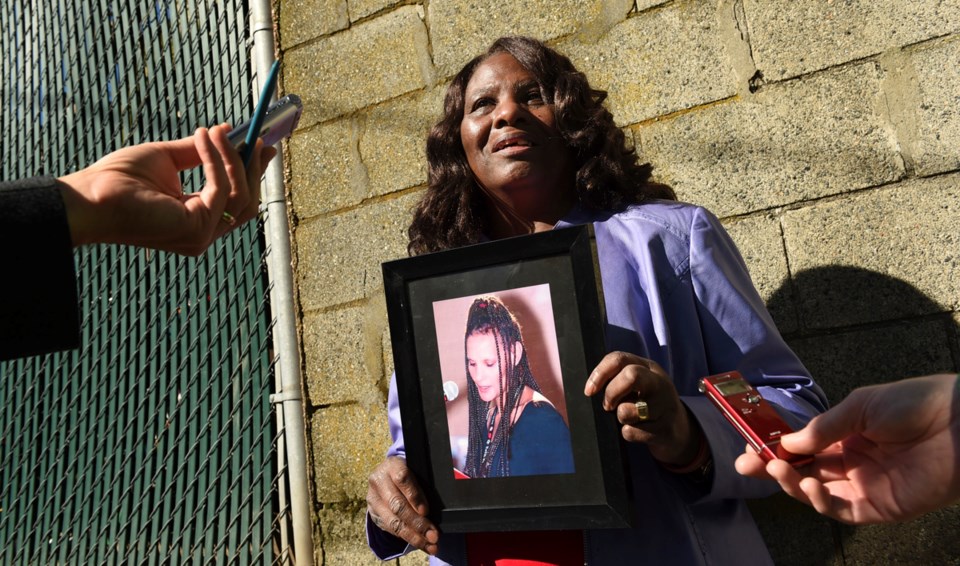Anita Hauck was 44 and homeless when she died.
How she died is a difficult story to tell for her mother, who stood in the sunshine Tuesday in an East Side parking lot and held a photograph of her daughter for media cameras.
Six months ago, on Sept. 27, Hauck climbed into a clothing donation bin in Maple Ridge to retrieve a jacket and a blanket for a fellow homeless person living in a tent city.
She got stuck, lost consciousness and died in hospital the next day. Hauck, who was battling a drug addiction and homeless for three years leading up to her death, left behind five children and a mother who was struggling Tuesday with the six-month anniversary of her daughter’s death.
“At her memorial, there must have been about 200 people, ” said 71-year-old Loretta Sundstrom, after leaving a news conference at the offices of Megaphone Magazine and Pivot Legal Society, where a report was released that revealed 325 homeless people died in B.C. between 2006 and 2014.
Hauck’s death wasn’t captured in the statistics because the B.C. Coroners Service has yet to tabulate the number of homeless deaths for 2015. But Hauck’s life story — which took a turn when she was raped at 15 by a group of men — was central to the release of Megaphone’s report, Still Dying on the Streets, and illustrated the need for more housing and treatment centres. Hauck was in a destructive relationship with her husband when she became homeless, her mother said.
“The high cost of housing, the lack of affordable housing and a lack of strong social and health supports has led to this crisis and this increase in homeless deaths,” said Sean Condon, executive director of Megaphone, noting 46 homeless people died in B.C. in 2014, with eight in Metro Vancouver and 14 in the Fraser region, which includes Surrey and Coquitlam.
What was consistent in 2014 and in the statistics dating back to 2006 was that drugs and alcohol were linked to the majority of homeless people who died. With 465 illicit drug deaths recorded in 2015, Condon suspects the number of homeless deaths in 2015 will surpass the 46 in 2014.
The statistics show the majority of homeless people who die are men between the ages of 40 and 49. Almost 16 per cent of all reported homeless deaths are aboriginal people, despite making up 5.4 per cent of the general population.
Judy Graves, the city’s former homeless advocate, said many deaths are preventable, particularly in a country as wealthy and sophisticated as Canada.
“We have people dying in the streets of infection,” said Graves, who paused to gather her thoughts. “This is really hard because as I talk, I’m thinking of one person after another that I’ve known. I think about Richard Starr, who died on the street on the coldest night of the year — not because it was cold, but because he was so badly infected. How can that happen in Canada?”
Prime Minister Justin Trudeau’s government announced in its budget last week that it will increase funding for affordable housing and homelessness programs and commit to develop a national housing strategy.
Asked to comment on the promises, Condon said he was encouraged by the government’s budget but that it fell short in dollars. New affordable social housing will likely not be built for several years, he added.
“This is still a delay and it does not address the immediate crisis,” he said.
Graves was the city’s homeless advocate when Mayor Gregor Robertson’s administration took over city hall in 2008. The mayor failed in his goal to end “street homelessness” by 2015. Last year’s homeless count recorded 488 people on the street and 1,258 in some form of shelter.
Asked to rate the performance of Robertson’s administration as it relates to getting people off the street, Graves said: “I know there was a deep and sincere effort made — [the mayor] has made a real difference. And I think we all know, realistically, that no municipality can do this alone — that we need funds and goals from other levels of government.”
@Howellings



